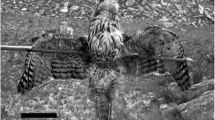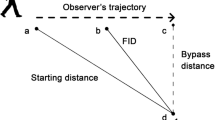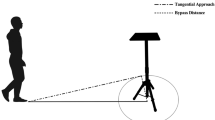Abstract
Avian escape strategy is highly dependent on the ability to fly, and the success rate of raptor attacks is reduced if the prey gets fully airborne. Therefore, when escaping from predator attacks, the initial take-off is crucial and a rapid take-off, high velocity, and high angle of ascent maximize the chance of survival. However, due to the laws of gravity, birds face a trade-off between maximizing its linear acceleration and maximizing its rate of climb when taking off. The optimal policy between velocity and angle of ascent when a bird escapes from an attacking predator might depend on the detailed nature of the predator’s attack, the proximity to cover, and the presence of conspecifics. Many small birds rely on a quick dash to protective cover. In this study, we examine how the availability of protective cover affects take-off strategy in birds. Male great tits (Parus major) were subjected to a surprise attack by a model predator either in the presence or absence of protective cover. When attacked by the predator, great tits took off and perched in the cover when it was available. Birds subjected to the predator attack in the absence of cover took off in 10° higher angle of ascent and flew faster in the start of the take-off, compared to birds that took off in the presence of cover. Thus, this study for the first time shows that a bird do trade off speed with angle of ascent in an adaptive way, depending on the presence of protective cover.




Similar content being viewed by others
References
Bednekoff PA (1996) Translation mass dependent flight performance into predation risk: an extension of Metcalfe & Ure. Proc R Soc Lond B 263:887–889
Cresswell W (1993) Escape responses by redshanks, Tringa totanus, on attack by avian predators. Anim Behav 46:609–611
Cresswell W (1996) Surprise as a winter hunting strategy in sparrowhawks Accipiter nisus, Peregrines Falco peregrinus and Merlins F. columbarius. Ibis 138:684–692
Hedenström A, Rosén M (2001) Predator versus prey: on aerial hunting and escape strategies in birds. Behav Ecol 12:150–156
Howland HC (1974) Optimal strategies for predator avoidance: the relative importance of speed and manoeuvrability. J Theor Biol 47:333–350
Kenward RE (1978) Hawks and doves: factors affecting success and selection in goshawk attacks on woodpigeons. J Anim Ecol 47:449–460
Krams I (2002) Mass-dependent take-off ability in wintering great tits (Parus major): comparison of top-ranked adult males and subordinate juvenile females. Behav Ecol Sociobiol 51:345–349
Kullberg C (1998) Does diurnal variation in body mass affect take-off ability in wintering willow tits? Anim Behav 56:227–233
Kullberg C, Jakobsson S, Fransson T (1998) Predator-induced take-off strategy in great tits (Parus major). Proc R Soc Lond B 265:1659–1664
Lima SL (1987) Distance to cover, visual obstructions, and vigilance in the house sparrows. Behaviour 102:231–238
Lima SL (1990) Protective cover and the use of space: different strategies in finches. Oikos 58:151–158
Lima SL (1993) Ecological and evolutionary perspectives on escape from predatory attack: a survey of North American birds. Wilson Bull 105:1–215
Lima SL, Wiebe KL, Dill LM (1987) Protective cover and the use of space by finches: is closer better? Oikos 50:225–230
Lind J, Kaby U, Jakobsson S (2002) Split-second escape decisions in blue tits (Parus caeruleus). Naturwissenschaften 89:420–423
Lind J, Hóllen L, Smedberg E, Svensson U, Vallin A, Jakobsson S (2003) Detection distance influencing escape behaviour in two parids (Parus major and P. caeruleus). J Avian Biol 34:233–236
Lindström Å (1989) Finch flock size and risk of hawk predation at a migratory stopover site. Auk 106:225–232
Newton I (1986) The sparrowhawk. Poyser, Carlton
Pulliam HR, Mills GS (1977) The use of space by wintering sparrows. Ecology 58:1393–1399
Rudebeck G (1950) The choice of prey and modes of hunting of predatory birds with special reference to their selective effect. Oikos 2:65–88
Van der Veen IT, Lindström KL (2000) Escape flights of yellowhammers and greenfinches: more than just physics. Anim Behav 59:593–601
Witter MS, Cuthill IC (1993) The ecological costs of avian fat storage. Philos Trans R Soc Lond B 340:73–92
Ydenberg RC, Dill LM (1986) The economics of fleeing from predators. Adv Study Behav 16:229–249
Acknowledgment
We thank Will Cresswell, Sven Jakobsson, and Indrikis Krams for the valuable comments on the manuscript. This research was funded by the Swedish Research Council (to C.K.). The experiment complies with the current laws in Sweden.
Author information
Authors and Affiliations
Corresponding author
Additional information
Communicated by W. Wiltschko
Rights and permissions
About this article
Cite this article
Kullberg, C., Lafrenz, M. Escape take-off strategies in birds: the significance of protective cover. Behav Ecol Sociobiol 61, 1555–1560 (2007). https://doi.org/10.1007/s00265-007-0387-1
Received:
Revised:
Accepted:
Published:
Issue Date:
DOI: https://doi.org/10.1007/s00265-007-0387-1




